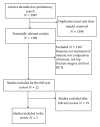Home-Based Multidisciplinary Rehabilitation following Hip Fracture Surgery: What Is the Evidence?
- PMID: 24455275
- PMCID: PMC3877638
- DOI: 10.1155/2013/875968
Home-Based Multidisciplinary Rehabilitation following Hip Fracture Surgery: What Is the Evidence?
Abstract
Objective. To determine the effects of multidisciplinary home rehabilitation (MHR) on functional and quality of life (QOL) outcomes following hip fracture surgery. Methods. Systematic review methodology suggested by Cochrane Collboration was adopted. Reviewers independently searched the literature, selected the studies, extracted data, and performed critical appraisal of studies. Summary of the results of included studies was provided. Results. Five studies were included. Over the short-term, functional status and lower extremity strength were better in the MHR group compared to the no treatment group (NT). Over the long-term, the MHR group showed greater improvements in balance confidence, functional status, and lower extremity muscle strength compared to NT group, whereas the effect on QOL and mobility was inconsistent across the studies. Several methodological issues related to study design were noted across the studies. Conclusion. The MHR was found to be more effective compared to the NT in improving functional status and lower extremity strength in patients with hip fracture surgery. Results of this review do not make a strong case for MHR due to high risk of bias in the included studies. Further research is required to accurately characterize the types of disciplines involved in MHR and frequency and dosage of intervention.
Similar articles
-
Effectiveness of Multicomponent Home-Based Rehabilitation in Elderly Patients after Hip Fracture Surgery: A Randomized Controlled Trial.J Pers Med. 2022 Apr 18;12(4):649. doi: 10.3390/jpm12040649. J Pers Med. 2022. PMID: 35455765 Free PMC article.
-
How has the impact of 'care pathway technologies' on service integration in stroke care been measured and what is the strength of the evidence to support their effectiveness in this respect?Int J Evid Based Healthc. 2008 Mar;6(1):78-110. doi: 10.1111/j.1744-1609.2007.00098.x. Int J Evid Based Healthc. 2008. PMID: 21631815
-
The Effectiveness of Integrated Care Pathways for Adults and Children in Health Care Settings: A Systematic Review.JBI Libr Syst Rev. 2009;7(3):80-129. doi: 10.11124/01938924-200907030-00001. JBI Libr Syst Rev. 2009. PMID: 27820426
-
Effectiveness of Supervised Home-Based Exercise Therapy Compared to a Control Intervention on Functions, Activities, and Participation in Older Patients After Hip Fracture: A Systematic Review and Meta-analysis.Arch Phys Med Rehabil. 2019 Jan;100(1):101-114.e6. doi: 10.1016/j.apmr.2018.05.006. Epub 2018 Jun 7. Arch Phys Med Rehabil. 2019. PMID: 29885311
-
Effect of Clinical Care Pathways on Quality of Life and Physical Function After Fragility Fracture: A Meta-analysis.J Am Med Dir Assoc. 2019 Jul;20(7):926.e1-926.e11. doi: 10.1016/j.jamda.2019.02.022. Epub 2019 Apr 8. J Am Med Dir Assoc. 2019. PMID: 30975586
Cited by
-
Changes in social participation and life-space mobility in newly enrolled home-based rehabilitation users over 6 months.J Phys Ther Sci. 2020 Jun;32(6):375-384. doi: 10.1589/jpts.32.375. Epub 2020 Jun 2. J Phys Ther Sci. 2020. PMID: 32581429 Free PMC article.
-
Factors associated to functioning and health in relation to home rehabilitation in Sweden: a non-randomized pre-post intervention study.BMC Geriatr. 2021 Jul 6;21(1):416. doi: 10.1186/s12877-021-02360-1. BMC Geriatr. 2021. PMID: 34229616 Free PMC article. Clinical Trial.
-
Clinical Practice Guideline for Postoperative Rehabilitation in Older Patients With Hip Fractures.Ann Rehabil Med. 2021 Jun;45(3):225-259. doi: 10.5535/arm.21110. Epub 2021 Jun 30. Ann Rehabil Med. 2021. PMID: 34233406 Free PMC article.
-
Outpatient and Home-Based Treatment: Effective Settings for Hip Fracture Rehabilitation in Elderly Patients.Geriatrics (Basel). 2021 Aug 27;6(3):83. doi: 10.3390/geriatrics6030083. Geriatrics (Basel). 2021. PMID: 34562984 Free PMC article.
-
Evaluating the impact of a home-based rehabilitation service on older people and their caregivers: a matched-control quasi-experimental study.Clin Interv Aging. 2018 Sep 12;13:1727-1737. doi: 10.2147/CIA.S172871. eCollection 2018. Clin Interv Aging. 2018. PMID: 30254432 Free PMC article.
References
-
- Handoll HH, Sherrington C, Mak JC. Interventions for improving mobility after hip fracture surgery in adults. Cochrane Database of Systematic Reviews. 2011;(3)CD001704 - PubMed
-
- Leslie WD, Metge CJ, Azimaee M, et al. Direct costs of fractures in Canada and trends 1996–2006: a population-based cost-of-illness analysis. Journal of Bone and Mineral Research. 2011;26(10):2419–2429. - PubMed
-
- Crotty M, Unroe K, Cameron ID, Miller M, Ramirez G, Couzner L. Rehabilitation interventions for improving physical and psychosocial functioning after hip fracture in older people. Cochrane Database of Systematic Reviews. 2010;(1)CD007624 - PubMed
-
- Chiu M-H, Hwang H-F, Lee H-D, Chien D-K, Chen C-Y, Lin M-R. Effect of fracture type on health-related quality of life among older women in Taiwan. Archives of Physical Medicine and Rehabilitation. 2012;93(3):512–519. - PubMed
Publication types
LinkOut - more resources
Full Text Sources
Other Literature Sources
Research Materials


